The baby has ear symptoms. Inflammation in the ear in infants
Refining the diagnosis is an important factor in the patient’s recovery. Diagnosis of any disease begins with the clarification of complaints. Having specified them, the doctor proceeds to an objective examination. Diagnosis of diseases in newborns is complicated by the fact that they cannot state their complaints and, consequently, determine the place of the disease. Parents and doctors should rely on indirect and objective signs of the disease.
In cases where there are objective signs of the disease, the diagnosis is more simple. The presence of cough, runny nose, dyspeptic disorders or changes in the skin make it possible to immediately suspect this or that pathology. Much more difficult to have when the affected organ is not accessible to visual observation.
Signs of otitis
The main complaint for otitis is earache.
Its intensity can be different, from the severity and noise in the ear to the pulsating, shooting pain that interferes with sleeping and doing ordinary things. The next sign is ear congestion and hearing loss, sometimes even its absence. However, the disease is often characterized by asymmetrical lesions, so patients do not always notice the presence of this symptom. The functionality of the second ear compensates for the defects of the affected.
One of the symptoms of otitis, which is easy to clarify with the help of a simple mercury thermometer, is a rise in body temperature to 38-39 degrees.
However, the presence of hyperthermia is not a pathognomonic symptom in otitis.
An increase in body temperature is observed in any inflammatory or infectious process, endocrine disorders, oncopathology, etc. In addition, the sluggish course of otitis can be characterized by normal temperature indices.
Another important and very informative symptom is suppuration. This symptom manifests itself sticky, yellowish secretions from the outside auditory canal. Their presence characterizes the development purulent inflammation middle ear. However, it is wrongful to consider this symptom permanent even with such otitis development, since the discharge of pus can be carried out not only through the injured eardrum, but also through auditory tube. Discharge from the auditory canal is not marked.
Thus, objective, such as fever or suppuration, are not permanent. The earlier treatment is started, the more effective it is, the lower the risk of developing severe complications. In order for the patient to receive timely qualified expert advice, in the case of ear inflammation, the patient’s subjective complaints play a large role. 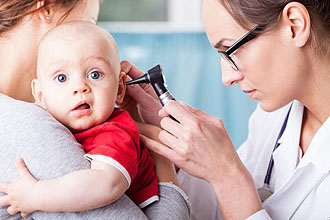 Determining the location of the disease greatly simplifies the diagnosis of the disease.
Determining the location of the disease greatly simplifies the diagnosis of the disease.
Difficulties of diagnosis in newborns
Adult patients and older children can clearly indicate the place of the disease, characterize the pain. How to understand that a baby has an ear ache? This is indeed a difficult problem, since children at that age cannot state their complaints. At the same time, medical tactics directly depend on the nature of the ear inflammation, catarrhal or purulent, as well as the condition eardrumwhether it is holistic or its perforation is noted. In otitis media, timely consultation of an ENT specialist is very important. It is the otolaryngologist who is able to clarify the diagnosis and prescribe the correct treatment. Parents in this situation should suspect otitis in the shortest possible time. To do this, they need to know how to check whether the ears hurt the baby.
Anxiety
First of all, you need to pay attention to the patient's condition. A typical sign of many infectious and inflammatory diseases is weakness and malaise. Such patients are sluggish, drowsy. If there is earache, the child is restless. He rushes about in bed, twists his head, occasionally screaming.
Similar symptoms may develop in the presence of abdominal pain in children. However, in this case, the appearance of anxiety is often associated with eating. In addition, rumbling, bloating, diarrhea, or constipation may occur. Older children may try to indicate the place of the disease, trying to touch the ear with a hand, scratch it.
There is an objective indication of how to determine that a baby’s ears hurt. To confirm the diagnosis using a finger on the tragus of the ear. Carrying out such a manipulation leads to an increase in air pressure in the external auditory canal. It, in turn, provides additional pressure on the eardrum and the tympanic cavity, the mucosa of which is already involved in the inflammatory process. In the presence of otitis, this action leads to increased pain and is the answer to how to know that the baby's ears hurt.
To determine if the baby’s ear hurts, careful observation of the child is necessary. Like any disease, otitis is characterized by malaise, lack of appetite, poor sleep. However, in babies, reduced appetite is also due to increased pain during sucking movements. Feeding a baby in the presence of inflammation in the ear looks like a child is taken for food, then with a cry from 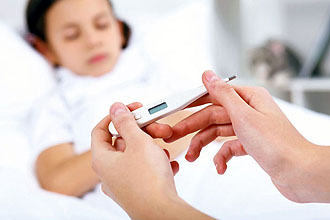 she refuses. Attentive parents on such grounds may suspect the development of otitis in a child.
she refuses. Attentive parents on such grounds may suspect the development of otitis in a child.
When the ears of a baby hurt, the symptoms of the disease are similar to signs of otitis in adults:
- the development of pain;
- hearing loss;
- temperature rise to 38-39 degrees.
Inflammation of the ear in infants is a secondary disease, a complication of ARVI and other pathology of the upper respiratory tract.
Many diseases of the nasopharynx are accompanied by impaired patency of the auditory tube. As a result, stagnation in the cavity of the middle ear. Consequently, runny nose, nasal congestion are also concomitant signs of otitis.
Otoscopy value
It is possible to reliably find out whether the ear is hurting a baby, only after consulting an otolaryngologist and performing an instrumental diagnosis, otoscopy. It is by the state and external signs of the eardrum that the otolaryngologist makes conclusions about the presence of one or another form of otitis. The unchanged form of the eardrum, with a smooth shiny surface, without traces of ulceration, thickening indicates the absence of inflammation of the middle ear in this patient.
Diagnosis of otitis externa
For the detection of otitis externa instrumental diagnostics is not required.
The presence of infiltration, suppurative focus. The ENT doctor can determine visually by examining the external auditory canal or auricle. In this case, the symptoms of otitis are hyperemia, swelling of the affected ear. but external otitis is an extremely rare pathology for newborns.
To understand that the ear of a newborn child is painful - an important task facing parents and a pediatrician. Timely consultation of an otolaryngologist will help reduce the risk of complications, improve the condition of the child in a short time.
In the first three or four years of life, babies are susceptible to all sorts of colds. No exception is ear disease, which is difficult to recognize. The sensitivity of the ears in infants is much greater than in an adult. Anatomical structure plays an important role in this. The connection of the nasopharynx with the ear is carried out using the Eustachian tube. It is a bit shorter in size, but wider than in older kids. In case of a cold, the infection provokes a blocked pipe, causing pressure in the auditory cavity. This leads to inflammatory processes.
Also, the cause of otitis can be called and the ingress of milk or artificial mixtures. A recumbent position contributes to this.
Propensity to allergic reactions, a weakened immune system, frequent diseases of the respiratory system - all this contributes to the appearance of otitis in a child.
Signs of otitis
Older children can tell or show where their pain is. To determine the signs of otitis in infants is not an easy task. Observation of the child's behavior may give a hint. The time of day at which the exacerbation falls is evening.
A symptom may be a temperature suddenly rising to 40 degrees. During feeding, a hungry child leaves to suck the breast, cries, twirling his head restlessly.
Recognizing the signs, you must try to gently push your fingers on the area in front of the ears. If there is pain, the baby will try to stray, turning its head around and cry. In this case, you must urgently go to the hospital.
Otitis treatment methods
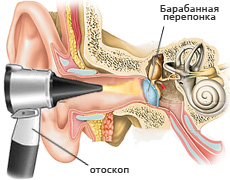 Since otitis media in infants is directly related to inflammation of the mucous membrane of the nasopharynx, then treatment should begin with this problem. The obstruction of the nose prevents the baby from breathing normally and is affected by the pain in the ears. Application drugs necessary in the early days. They will help stop the development of the infection. Bathing and walking in the air is best postponed for a while. An alternative to bathing may be rubbing up the spots for the emergence of the bottom hole. A soft towel and lukewarm water are wiped, the neck area, the forehead and the folds.
Since otitis media in infants is directly related to inflammation of the mucous membrane of the nasopharynx, then treatment should begin with this problem. The obstruction of the nose prevents the baby from breathing normally and is affected by the pain in the ears. Application drugs necessary in the early days. They will help stop the development of the infection. Bathing and walking in the air is best postponed for a while. An alternative to bathing may be rubbing up the spots for the emergence of the bottom hole. A soft towel and lukewarm water are wiped, the neck area, the forehead and the folds.
Cleaning the spout should be carried out before each instillation. To do this, use a cotton swab, which is dipped in breast milk. Nasal droplets must be warm, so as not to bring discomfort to the child.
Choosing drops in the ears, you need to remember that inflammation in otitis is catarrhal (without discharge from the ear canal) and purulent (the symptom is discharge from the ear). The disease of purulent otitis is characterized by the formation of a small hole in the eardrum, through which the purulent mass flows. The presence of alcohol in the medication will cause severe pain in the infant and prolong the tightening of the wound. Improper treatment often leads to a chronic stage of the disease, which cannot be tolerated. When pus is leaking, no tampons are allowed, because the liquid should not remain in the ear of the child, but should be removed from there.
Treatment with symptoms of catarrhal otitis is to bury the ears with warm drops several times a day. In their absence, the use of boric alcohol is allowed.
Cotton swabs, laid in the ears after dripping, warm and hold the medicine, not allowing it to flow. A good aid in the treatment will be a compress.
Types of compresses and their use
A warming dry compress is indicated for the treatment of otitis. It will require a large cotton ball, which is applied to the diseased ear. A cap or any other headgear is put on top, the main thing is that it should sit tight. You can put the baby to sleep with this bandage.
If the child has a low temperature, you can put a vodka or alcohol compress. To this end, the alcohol-containing liquid is diluted with water, heated. In a piece of soft matter, make a cut along the length of the ear, wet the fabric in the prepared mixture, put it on the auricle, leaving it on top. Cut a similar piece of cellophane or wax paper, put on top. Cover all with a piece of cotton and hide under the cap. It is necessary to put a compress at night and keep it until the morning.
When breastfeeding it is impossible to fully insure a child against the occurrence of diseases. Otitis is diagnosed periodically in newborns. The process occurs against the background of inflammation of the inner part of the ear. The situation develops and may lead to the addition of infection. If you do not get rid of the disease in time, then the risk of serious complications increases. That is why otitis should be recognized at an early stage.
Causes of otitis
It is important to know the causes of otitis and to try to completely protect the crumbs from their negative impact:
- Pathology often develops on the background of complications after suffering cold disease. The situation is significantly aggravated if the necessary therapy has not been provided.
- Otitis can develop on the background of a domestic injury. That is why parents should be extremely careful when cleaning the ear canal of the crumbs.
- Otitis during breastfeeding may develop when milk or a mixture gets into the inner part of the ear. The fact is that in children under one year the connecting canal between the ear and the nasopharynx is very thin. If the baby is immediately turned over after feeding, then a small part of the liquid is able to penetrate into inner ear. If it does not flow out, the risk of active infection increases. It is important to prevent the situation and timely remove the fluid from the ear canal.
- Children under two years have an increased risk of adenoid growth. It is especially dangerous if at this moment there are infectious cells in the ear canal. They provoke inflammation in the middle ear, so they are very dangerous.
- In a newborn, otitis can develop against the background of congenital diseases of the pulmonary system.
- Allergic reaction to food or other external components.
- Spontaneous pressure can be applied to the eardrum. This situation occurs in the plane or abrupt descent, ascent.
- Immunity crumbs weakened. The protective functions of the body are affected if the crumb is on an artificial feeding option.
The nature of the manifestation of the disease
Parents should know the signs of otitis in infants, thanks to which they will be able to prevent the disease from getting worse:
The main symptoms of the disease:
- It is easy to understand that a baby has otitis. During feeding, he begins to act up and actively shake his head. The situation passes on the background of the influence of the reflex. At the moment, the baby is experiencing severe pain in the ears, which prevents him. If the situation is not stopped in time, then the crumb can completely refuse to eat.
- Symptoms of otitis in infants are accompanied by an increase in body temperature up to 40 degrees.
- If you press hard on the ear shell, then the baby begins to experience severe pain. Some babies try to close it with pens.
- Newborns and infants have worsened sleep, which will eventually lead to insomnia.
- Vomiting occurs spontaneously and has nothing to do with problems in the gastrointestinal tract.
- The course of the disease is exacerbated by the common cold and severe redness in this area.
- Parents can also detect respiratory depression. The child begins to breathe through the mouth, and shortness of breath is observed after active movements.
- Most dangerous is purulent otitis. In this case, the ear stands out clear liquidwhich confirms the presence of infection inside.
Parents should not ignore the obvious signs of otitis baby. Symptomatology is often complex. Timely treatment of otitis will avoid serious complications in the future. If the baby has become capricious and cries a lot, then parents should carefully analyze the situation and eliminate the cause.
Using a wet compress to treat otitis
The main methods and features of the treatment of disease in infants
It is important to recognize the symptoms of otitis in an infant. In this case, it will be possible to eliminate the disease in a short time. Only a doctor can determine how to treat otitis. Self-treatment not only does not give the proper result, but can only aggravate the course of the disease. In this case, the risk of complications and the transition of the disease to the chronic stage increases.
It is possible to treat otitis in infants at home. For this it is not necessary to go to the hospital. However, it is necessary to consult a doctor. He will be able to carefully analyze the situation and choose effective methods of eliminating the symptoms and directly the inflammation itself. You should contact only experienced laura.
We have already figured out how to recognize otitis media in infants. It remains only to install techniques that will quickly and effectively get rid of the disease:
- External otitis can be quickly cured with a dry and warm compress. For this, according to a special technique, it is necessary to make small tampons that are laid in the ear canal. To improve the effect on them you need to wear a warm hat. It is necessary to refuse this method of treatment if the disease is accompanied by the release of a large amount of pus. In this case, the regular application of compresses can only aggravate the nature of the symptoms.
- To resort to the wet compress method is necessary if the child has an increase in body temperature above 37.5 degrees. For its preparation, the cotton wool is soaked with alcohol and applied directly to the ear area itself. However, direct placement in the ear canal should be avoided.
- Quickly eliminate catarrhal otitis enable blue lamp. The device is used to reduce pain. To improve the effect, it must be used before each feeding. In this case, the baby is guaranteed to have an appetite, and he can eat well.
- For the elimination of otitis in ancient times a complex of medicinal herbs was used. They are preferred today, because they can not harm the body of the baby. For example, not all medicines and drops are allowed for treatment. month child. Get rid of otitis allows the use of sap geranium or aloe.
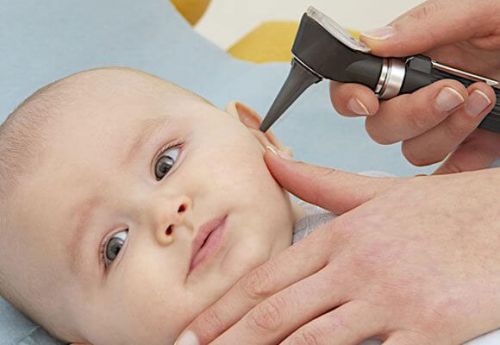
Ear drops can only choose the right doctor
If, in addition, the patient has an increase in body temperature, then medications cannot be dispensed with. Otherwise, the risk of developing exhaustion and refusal to eat is increased. With severe course disease can not be done without antibiotics or drugs against the virus. Only a doctor can determine otitis in a baby and find the right course of treatment. Self-selection of the drug is strictly prohibited. A large number of positive reviews receives Otipaks. These drops have an adapted composition, so they can be used to treat an infant.
Preventing the development of the disease
As one of the main methods of preventing the development of otitis, you need to regularly clean middle channel ear. To do this, it is advisable to use soft ear sticks. Parents should not seek to go too deep inside. During and some period after it, for a nursing mother, it is necessary to hold the baby in an upright position. Due to this, the liquid will not be able to penetrate into the ear canal and form a favorable environment for the growth of infections.
Check for the presence of child otitis should be immediately after a cold. The situation with complications can be avoided only if a course of treatment was originally chosen. In this case, the probability of inflammation is reduced to a minimum.
The symptoms and treatment of otitis are inextricably linked. It is important to recognize them in time and seek help from a specialist. To avoid the accumulation of mucus in the ear canal is possible only if it is provided with sufficient drink. Fluid promotes rapid removal of harmful components. Due to this, the probability of clogging is minimized. It is important to provide the baby with an optimal temperature in the room. The room should not be more than 20 degrees. If the baby is suspected ear inflammation, then he must constantly wear a hat. Even in the warm season, it can prevent the penetration of harmful components inside. For the time being it is necessary to refuse walks in the fresh air in windy weather.
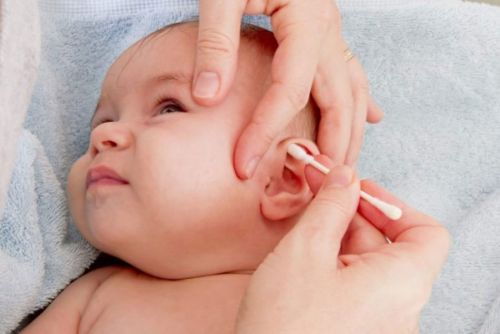
Careful care pinna prevent the development of diseases
Otitis danger for an infant
For hearing, the condition of the middle ear canal is important. If there is inflammation or damage, it is necessary to immediately begin a course of treatment. Otherwise, the baby may lose hearing, which cannot be restored even with the help of surgery. If the damage has reached the inside, then it will be much more difficult to get rid of hearing impairment.
Against the background of otitis, a lesion of the sinuses of the ear or brain can also develop. The situation is not only dangerous, but can aggravate the work of the heart or the respiratory system. If a pain sensations If you are chasing a child for a long time, the disease can lead to hearing loss in whole or in part.
Purulent otitis media can develop into meningitis. In this case, the baby suffers from severe pain. The situation exhausts and exhausts the body, so the child does not sleep well and refuses to eat.
Opinion of experts
At the first stage of the patient's treatment to the doctor, the integrity of the eardrum is established. In the process of examination using the otoscope. If there is damage to the eardrum, drops or other medications are not allowed.
The eardrum will need to be pierced to remove pus from the passageway. This will stop development purulent otitis. At this stage the disease is characterized severe painwhich bring a little inconvenience to the little patient.
Among the causes of otitis in the first place are adverse external influences. However, a link was established with a genetic predisposition. The fact is that in some babies the ear canal is located at the wrong angle. Due to this, the liquid from the nasopharynx can easily penetrate the ear canal.
If the treatment is chosen correctly, then otitis will not affect the hearing of the child. Only in some cases, its partial loss is observed within three months. This situation is considered normal and passes on its own.
Some experts advise not to resort to procedures associated with heating the ear. If pus accumulates inside, high temperatures can only aggravate the course of otitis. In this case, the baby will also experience an increase in body temperature.
Otitis develops in direct correlation with conjunctivitis. If this eye disease was previously diagnosed, then it is necessary to further investigate the ear cavity. Parents should be attentive to the state of health of the patient and if there are negative symptoms, seek advice from your doctor.
The ear canal also affects the balance and functioning of the vestibular apparatus. If a child has problems with balance or movement, then you should seek help from Laura. He diagnoses or refutes the presence of otitis media in the crumbs.
Popular
- Breast cancer is curable at any stage.
- The remedy for the cold Sinupret
- Azitrox - official instructions for use
- Chicken-bjaka: allowed antibiotics were found in Russian chicken
- Oral Cancer: Symptoms and Treatment
- Dark and thick blood during menstruation.
- Modern analogues of doxycycline tablets
- Is it possible to die from pneumonia
- What earwax will tell all about your health
- Tussin: instructions for use



